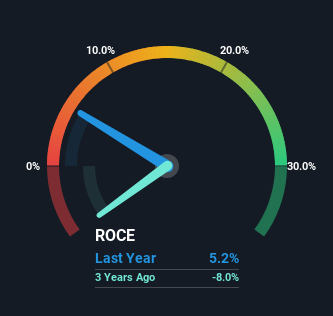- Japan
- /
- Personal Products
- /
- TSE:4920
There Are Reasons To Feel Uneasy About Nippon Shikizai's (TSE:4920) Returns On Capital

If we want to find a potential multi-bagger, often there are underlying trends that can provide clues. Firstly, we'll want to see a proven return on capital employed (ROCE) that is increasing, and secondly, an expanding base of capital employed. If you see this, it typically means it's a company with a great business model and plenty of profitable reinvestment opportunities. Although, when we looked at Nippon Shikizai (TSE:4920), it didn't seem to tick all of these boxes.
What Is Return On Capital Employed (ROCE)?
Just to clarify if you're unsure, ROCE is a metric for evaluating how much pre-tax income (in percentage terms) a company earns on the capital invested in its business. Analysts use this formula to calculate it for Nippon Shikizai:
Return on Capital Employed = Earnings Before Interest and Tax (EBIT) ÷ (Total Assets - Current Liabilities)
0.052 = JP¥548m ÷ (JP¥18b - JP¥7.5b) (Based on the trailing twelve months to May 2024).
Therefore, Nippon Shikizai has an ROCE of 5.2%. Ultimately, that's a low return and it under-performs the Personal Products industry average of 9.6%.
See our latest analysis for Nippon Shikizai

Historical performance is a great place to start when researching a stock so above you can see the gauge for Nippon Shikizai's ROCE against it's prior returns. If you'd like to look at how Nippon Shikizai has performed in the past in other metrics, you can view this free graph of Nippon Shikizai's past earnings, revenue and cash flow.
What Does the ROCE Trend For Nippon Shikizai Tell Us?
On the surface, the trend of ROCE at Nippon Shikizai doesn't inspire confidence. Around five years ago the returns on capital were 11%, but since then they've fallen to 5.2%. Although, given both revenue and the amount of assets employed in the business have increased, it could suggest the company is investing in growth, and the extra capital has led to a short-term reduction in ROCE. If these investments prove successful, this can bode very well for long term stock performance.
On a side note, Nippon Shikizai's current liabilities are still rather high at 42% of total assets. This effectively means that suppliers (or short-term creditors) are funding a large portion of the business, so just be aware that this can introduce some elements of risk. Ideally we'd like to see this reduce as that would mean fewer obligations bearing risks.
The Bottom Line
In summary, despite lower returns in the short term, we're encouraged to see that Nippon Shikizai is reinvesting for growth and has higher sales as a result. In light of this, the stock has only gained 3.5% over the last five years. Therefore we'd recommend looking further into this stock to confirm if it has the makings of a good investment.
If you want to know some of the risks facing Nippon Shikizai we've found 4 warning signs (1 is potentially serious!) that you should be aware of before investing here.
If you want to search for solid companies with great earnings, check out this free list of companies with good balance sheets and impressive returns on equity.
Valuation is complex, but we're here to simplify it.
Discover if Nippon Shikizai might be undervalued or overvalued with our detailed analysis, featuring fair value estimates, potential risks, dividends, insider trades, and its financial condition.
Access Free AnalysisHave feedback on this article? Concerned about the content? Get in touch with us directly. Alternatively, email editorial-team (at) simplywallst.com.
This article by Simply Wall St is general in nature. We provide commentary based on historical data and analyst forecasts only using an unbiased methodology and our articles are not intended to be financial advice. It does not constitute a recommendation to buy or sell any stock, and does not take account of your objectives, or your financial situation. We aim to bring you long-term focused analysis driven by fundamental data. Note that our analysis may not factor in the latest price-sensitive company announcements or qualitative material. Simply Wall St has no position in any stocks mentioned.
About TSE:4920
Nippon Shikizai
Researches and develops, manufactures, and sells cosmetics in Japan and internationally.
Slight and slightly overvalued.
Market Insights
Community Narratives



